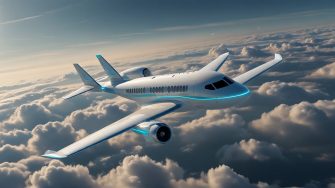Decarbonising flight
Dreams of powering the aviation industry towards net zero are closer to reality.
Dreams of powering the aviation industry towards net zero are closer to reality.

The aviation sector accounts for around 5% of Australia’s carbon dioxide emissions, but it is one of the most challenging sectors to decarbonise. And it’s still growing.
While the industry considers improvements to engines and sustainable biofuels to reduce carbon emissions, the potential for hydrogen-powered aircraft has already been demonstrated through various prototypes since the 1950s.
Today, the industry has reignited hydrogen’s potential, with Airbus planning to launch its first commercial hydrogen-powered aircraft by 2035. If they achieve this, and as the technology scales up, the aviation sector could potentially achieve net zero by 2050.
Dr Quentin Meyer from UNSW Sydney’s School of Chemistry says hydrogen is “the ultimate clean energy source. This is because it produces no carbon emissions."
Dr Meyer and Professor Chuan Zhao, also from the School of Chemistry, have centred their research on hydrogen fuel cells. These cells operate at zero total emissions—whereas, burning hydrogen as fuel with an internal combustion engine still emits nitrous oxide, which is a substantial greenhouse gas.
But there is still a way to go.
“One of the main challenges that hydrogen fuel cells have faced over the past two decades is finding the right application.”—Dr Quentin Meyer
When some of us imagine hydrogen-powered flight, images of the Hindenburg accident come to mind — as it catches fire and plummets to the Earth.
While it could be assumed that hydrogen was the culprit, the skin of the Hindenburg was painted with a flammable mix of cellulose acetate and aluminium powder—aka. rocket fuel. It then flew into an electrical storm as it dropped its moors to the ground, setting off sparks.
Today’s safety standards have vastly improved.
Dr Meyer was recently funded by Australia’s Economic Accelerator (AEA) to develop a working prototype of high-temperature fuel cells using low-cost catalysts for the aviation industry. The AEA supports the Australian Government’s Future Made in Australia plan, which enables leading entrepreneurial researchers to transform research into the nation's new industries, services and jobs of tomorrow.
“In the aviation industry, you want something as light as possible for take-off, taxi and landing,” Dr Meyer says. “The battery needed to power a truck accounts for about 30% of its weight—so just imagine the size of the battery needed for a plane flying from Australia to Asia, the US, or even Europe”.
He says what he and Prof. Zhao propose is a different type of fuel cell technology—which should be lighter and also cheaper than what's currently available. Their aim is to power drones with hydrogen fuel cells within the year. The next step beyond the project is scaling this up to larger aircraft.
“If you think back to 15 years ago, Tesla, as a fully electric car, wasn't on the market yet,” Prof. Zhao says. “But the Toyota Prius was, as a hybrid car technology. We had an electric battery in there, but it also could use petrol too.”
He says what he and Dr Meyer are trying to achieve is on the same path.
“Since the days of the Wright brothers, the aviation sector has relied solely on fossil fuels,” he says. “But we now have craft powered by hybrid hydrogen fuel cells—which means still using some other fuels too. This is like the first hybrid step for the aviation sector.”
Dr Meyer says one of the challenges of fuel cells has been device integration.
“Often, a fuel cell product is made first—and then it needs to be redesigned so it can be used in a device,” he says. “This is a costly and somewhat inefficient approach. But we’ll identify the drone we want at the beginning of the project and then design the fuel cell system around it.”
“This approach must remain the same for scaling up to larger aircraft one day—finding the aircraft first, then designing the fuel cell and system around it.”
The Australian government is currently reviewing Australia’s National Hydrogen Strategy, which aims for ‘a clean, innovative, safe and competitive hydrogen industry that benefits all Australians’. The strategy aims to position the country as a major global player by 2030. With that aim in sight, technological improvements for electrolysers—which split water into hydrogen and oxygen using electricity—are already lowering costs and increasing production potential.
Prof. Zhao is a world-leading expert in developing low-cost catalysts for water electrolysers and fuel cells. He has already invented several catalysts that massively boost the efficiency of hydrogen production from water.
He says, "we have already created some of the most efficient catalysts for water splitting, which is exciting. Our catalysts are not just efficient, but also cheap, sturdy and very simple to make. They can also be scaled up for the industrial application of water splitting.”
Some of these catalysts are already commercialised and manufactured at scale. They are used in hydrogen-producing plants, making hydrogen at a very low cost.
Creating these high-performance catalysts is a game-changer for the hydrogen economy.
“Fuel cells previously used large amounts of platinum, which is both very rare and very expensive,” Prof. Zhao says. “Our fuel cells team, led by Dr Meyer, had a recent breakthrough in platinum-free catalysts, which has given us unique tools to develop the next generation of low-cost materials.”
Together, Dr Meyer and Prof. Zhao are driving the next disruptive evolution for the field. They were recently awarded with a UNSW Commercialisation Seed Grant via UNSW Industry & Innovation.
Their long-term aim is to support the launch of a new Australian aviation industry based on clean aircraft that runs at low cost, low weight and high range.
The continued research, investment and collaboration between industry stakeholders and governments will be essential to overcoming the challenges on the road to making hydrogen aviation a reality.
Impact stories